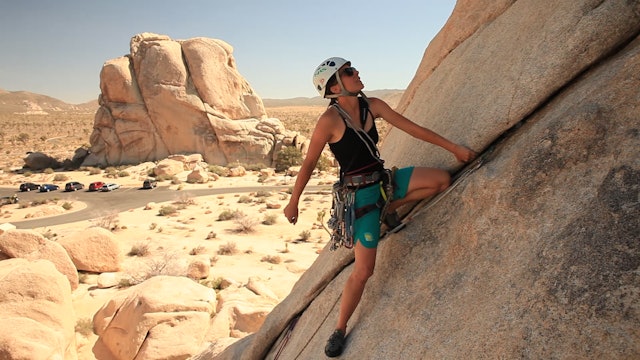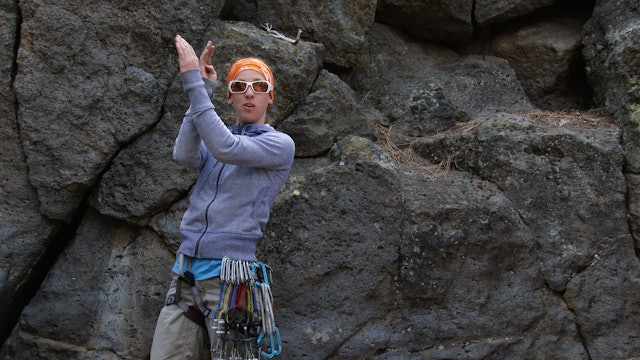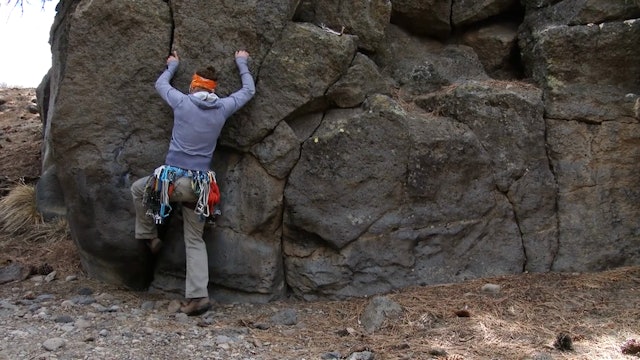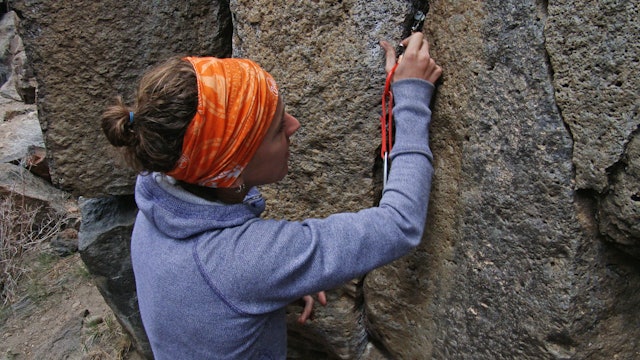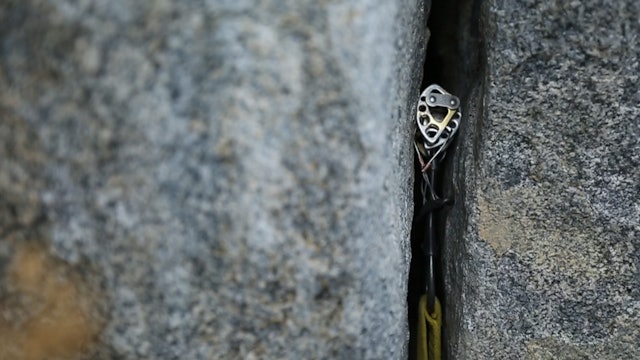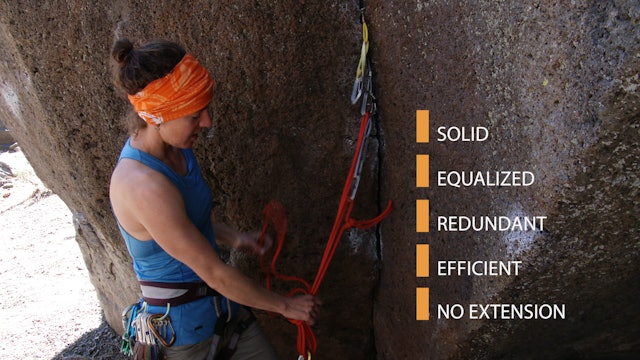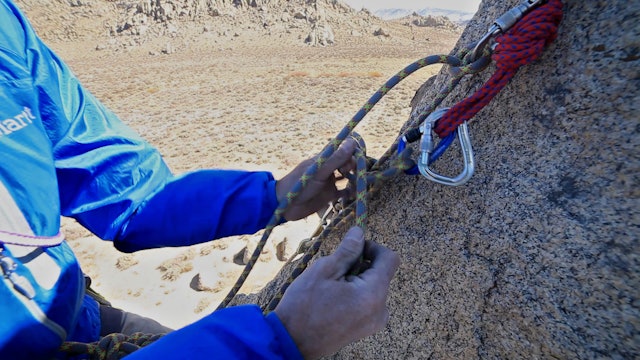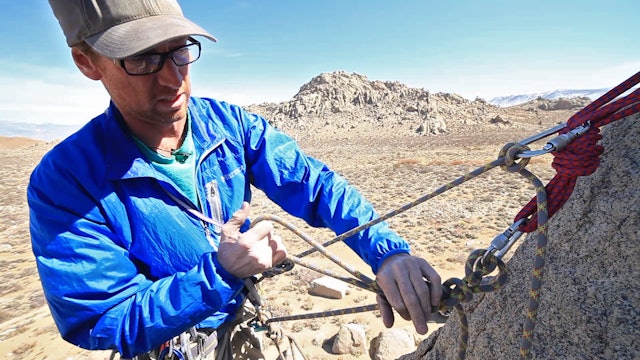Traditional Climbing
Our Traditional Climbing series showcases "trad" skills such as the use of camming devices for protection, building traditional anchors, and crack climbing.
By now, you should have watched our Sport Climbing series, plus our requisite Basic Anchor Building, Belaying, and Rappelling videos.
The skills contained in our Traditional Climbing series precede our Multi-Pitch Trad Climbing series—and should be considered a prerequisite. Once you have a handle on this series, check out our (separate) Multi-Pitch Trad Climbing videos for more advanced climbing skills.
Similar to ice climbing, strongly consider starting out with traditional climbing by top-roping (versus starting with lead climbing). First, learn to set a solid traditional anchor, then learn to place gear while mock leading (where you are belayed on a top rope but clipping in a separate rope to practice leading).
Let’s get started! Our Traditional Climbing video series is below. Be careful, and have fun!
Know & Go with ClimbingTechTips.com
Please remember that climbing is inherently dangerous. Climb at your own risk.
-
Traditional Climbing: 1. Hand Jamming
In this video we review the “hand jam”. Hand jamming is a technique used to climb cracks as opposed to featured faces or slabs.
This technique requires the climber to place their hand into the crack and tuck the thumb into the hand to create a narrow (karate chop shape) or wide (cup shape) han...
-
Traditional Climbing: 2. Crack Climbing Techniques
In this video we review crack climbing techniques. At first crack climbing can be a painful experience, but as you start to hone in on certain techniques, you’ll find that it can actually be quite fluid and enjoyable.
Below are a few considerations for crack climbing technique:
1. Make sure...
-
Traditional Climbing: 3. Finger Locks vs. Laybacking Cracks
In this video we review two techniques for climbing cracks: laybacking vs. using finger locks.
In any style of climbing, good technique will get you further than muscling your way through the climb. This underlines a key difference between laybacking and finger-jamming.
Laybacking - This te...
-
Traditional Climbing: 4. Toe Jamming
In this video we review considerations when toe or foot jamming to climb a crack. The difference between a toe and foot jam is how far your foot goes in the crack.
To jam your feet or toes in cracks, you use a twisting motion. The torque generates friction between your foot and both sides of t...
-
Traditional Climbing: 5. Creating Tape Gloves for Crack Climbing
In this video we review how to create tape gloves for crack climbing. Tape gloves are used to protect the back of your hand when crack climbing. Climbers will typically use tape gloves when crack climbing for multiple consecutive days, especially on rough or sharp rock (i.e. sandstone) in dryer c...
-
Traditional Climbing: 6. Cam Placement and Retrieval
In this video we look at how to place and remove cams.
The most important tip for retrieving a cam is also the simplest: first, try to visualize exactly how the cam was placed, then just reverse that motion to get it back out again.
For example, if the cam is placed in a narrow constricted...
-
Traditional Climbing: 7. Cam Placements - Hand Sized Cams
In this video we review considerations for placing hand-sized cams.
1. Pull the cam’s trigger until the lobes are about 70-80% cammed (100% is when you pull the trigger as far as it will go). If the cam is too small for the crack, we say it is “tipped out” (see video for visual).
2. Look f...
-
Traditional Climbing: 8. Cam Placements - Small Cams
In this video we review considerations for placing small cams. Small cams are cams that range from 0.5 - 2.5 inches in size. Because they are smaller, they also have a proportionally smaller range of crack sizes they will fit.
- Less leeway for placement size. Due to the smaller size, a small ...
-
Traditional Climbing: 9. Cam Considerations - 4 Lobe vs. 3 Lobe
In this video we review considerations between using a 4 lobe (Alien) vs 3 lobe (Metolius TCU) cams. Both can be useful, and have different applications (see below):
4 Lobe:
- Wider than the 3 lobe, so not ideal for shallow cracks.
- More surface area than 3 lobe, can inspire more confidence... -
Traditional Climbing: 10. Retrieving Stuck Cams
In this video we review considerations for retrieving stuck cams. Cams can get stuck for many reasons. Perhaps it was incorrectly placed, jammed into place when fully cammed, i.e. by a freaked out climber on lead in desperate need of protection. Sometimes the rope movement after the leader climbs...
-
Traditional Climbing: 11. Building Traditional Anchors - Part 1 of 2
In this video we review the fundamentals of building a traditional anchor system. You’ll notice we revisit the acronym of S.E.R.E.N.E., however this time we have added an extra “E”, which will be covered in the next video “Building Trad Anchors - S.E.R.E.N.E.”
For now, let’s start from the top...
-
Traditional Climbing: 12. Building Traditional Anchors - Part 2 of 2
In this video we continue reviewing the fundamentals of building a traditional anchor system. In our last video, we covered Solid and Equalized, now let’s review the following:
Redundant -
Check each of the pieces in the anchor to determine whether a failure in one point can cause the enti...
-
Traditional Climbing: 13. Assessing Trad Anchor Rock Quality
In this video we look at ways to assess rock quality for your traditional anchor. Consider two points:
1. Check to make sure the rock itself is solid by patting the rock with your hand. Listen for hollow sounds which might identify a detached block that is not visibly obvious. Avoid placing pr...
-
Traditional Climbing: 14. Alternative Trad Anchor - Consideration #1
What happens if you run out of slings while leading a pitch and arrive at the anchor with only a few cams—then realize you also forgot to grab your partner’s cordelette when you swung leads at the last transition. Don’t worry, use your rope!
Step 1: Place 3 pieces of gear.
Step 2: Give your...
-
Traditional Climbing: 15. Alternative Trad Anchor - Consideration #2
In this video we look at another way to build a traditional anchor in the event the climber has made it to the top of the route, has three pieces of gear to place, but does not have a cordelette or sling.
Step 1: Place your three pieces of gear.
Step 2: Give yourself a couple arms’ lengths ...
-
Traditional Climbing: 16. Trad Anchors with Slings vs. Cordelettes
In this video we review considerations for building a traditional anchor with slings, in the case where a cordelette is not available. To do this you may need a mix of shoulder length slings and double length slings.
Step 1: Place three solid pieces of gear.
Step 2: Using a shoulder length ...
-
Traditional Climbing: 17. Combining Optimal Anchor Placements with Marginal Gear
What happens when you are not convinced that three anchor pieces is enough to make a solid anchor? Maybe rock quality is marginal, the cracks are flared, or that stopper just doesn’t have good surface area contact with the rock.
In the video above, we highlight an example where two protection ...
-
Traditional Climbing: 18. Horizontal Trad Anchor
In this video we review considerations for horizontal traditional anchors, where the anchor pieces are all placed in a horizontal crack as opposed to a vertical crack.
Some considerations when using horizontal trad anchors include:
1. Lifespan of gear - Sustained weight or tension on horizo...
-
Traditional Climbing: 19. Maximizing Space at the Anchor
In this video we review ways to maximize space at the anchor when all members of your climbing party have reached the top of the route. Below are a few considerations:
1. Clip into the shelf - The shelf is located just above the master point, and can be used in addition to the master point to ...
-
Advanced Rockcraft - How to Escape the Belay with Re-Direct
In this video we look at how to escape a redirected belay. This is an advanced rockcraft skill that should be honed by anyone venturing into multi pitch terrain—but is also useful for cragging. You might use this skill to get the belayer out of the rope system in order to conduct emergency respon...
-
Advanced Rockcraft - How to Escape the Belay—Off your harness
In this video we look at how to escape a belay rigged directly on your harness. This is an advanced rockcraft skill that should be honed by anyone venturing into multi pitch terrain—but is also useful for cragging. You might use this skill to get the belayer out of the rope system in order to con...
-
Traditional Climbing: 22. "Coarse & Buggy" (5.11b) in Joshua Tree
In this video, CTT athlete Michelle Jung “sends” an ultra classic 5.11 route called Coarse & Buggy in California’s Joshua Tree National Park.
We hope you found this video helpful. Feel free to comment below with questions or thoughts!
Please remember, climbing is inherently dangerous. Cli...
